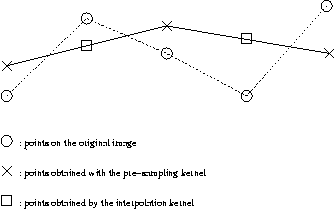Linear techniques


We first considered a set of linear techniques for the main reason that
they allow a systematic analytical approach.
We considered only 2-D separable filters, i.e. that can be expressed
as the product of two 1-D kernels of width k.

It allows a stronger analysis because we have powerful tools to construct
1-D filters. As long as we are not interested in any kind of orientation
analysis, this approach is perfectly sound although sub-optimal (otherwise
circularly symmetric
kernels would be necessary).
We concentrated on a subset of the 2-D separable filters verifying the
following properties :
-
symmetry : both halves of the neighborhood affect the pixel symmetrically

-
normalization : the reduced image maintains the average intensity of the
original image

-
unimodality : the closer a value is to the pixel, the stronger it affects
that pixel's value

"Haar" approach
-
REDUCE = EXPAND = top-hat function
Before the decimation, we simply take the average value of a square
of four pixels. In the interpolation step, the neighboring pixels get replicated
with no additional interpolation filtering.
Burt & Adelson approach [1]
-
REDUCE = EXPAND = Gaussian-like filter
The same weighting function is used for the REDUCE and the EXPAND
operations. It is a 5-by-5 filter which depends on only one parameter
: this class of filter is the only class of 5-by-5 separable filter
verifying the three properties mentioned above.
Ideal filter
-
REDUCE = EXPAND perfect low pass filter with cut off frequency at pi/2
This method is ideal in the sense of the reconstruction of the frequencies
comprised between 0 and pi/2. The image is first convolved by a sinc
to prevent any aliasing ; the lower resolution image is then interpolated
using the same filter to remove all the replications of the spectrum after
up sampling.
Optimal polynomial filters [2]
-
REDUCE = pre sampling filter optimized to minimize the MSE considering
the given REDUCE operator
-
EXPAND = piecewise polynomial interpolation
This approach fits a piecewise polynomial surface to the 2-D intensity function. The criterion for optimality is the
minimization of the MSE between the fitted surface and the original image
at the pixel points.
This approach is probably not optimal because minimizing the MSE does
not necessarily result in the best subjective image quality. However it
allows a systematic analysis.
The 2-D kernel is generated from the 1-D kernel. The REDUCE function
generates a chain of piecewise polynomial segments with fewer points (due
to the decimation) from the original one. The EXPAND function makes a polynomial
interpolation to assign values to the missing points.

figure : 1-Dimensional linear piecewise fitting
This optimization involved in the decimation happens to have a solution
that can be approximated
by a trucated kernel convolution. We
only considered two kernels : the linear and the cubic fitting kernels.
The width can be specified : we chose filters with large width (15) to
get better results. This is not damageable in terms of complexity since
the EXPAND function is not affected by that choice.
Splines [3]
In [3], a scheme that generates a L2 polynomial spline pyramid is proposed.
Polynomial splines of order n are piecewise polynomials that are connected
to guarantee the continuity of the function and its derivatives up to order
n-1. Splines are interesting for pyramidal coding for two reasons : first
because it is possible to adjust the coarseness of the representation by
varying the number of coefficients, thus enabling progressive data reduction.
Secondly because discrete spline operations can be formulated in terms
of separable convolutions (making by the way this scheme linear).
After a initial change of coordinates from image space to B-spline space
(or dual space), the EXPAND and REDUCE functions can be expressed as simple
FIR binomial filters. The changes in coordinates involve convolutions and
inverse convolutions with the B-spline kernels of order n and 2n+1 : b(n)
and b(2n+1). We approximated the inverse convolution by using a truncated
FIR filter obtained by inverting the frequency response of b(n). The decimation
and interpolation functions in 1-D are described below. The generalization
to 2-D can done by successive 1-D processings along the coordinates.
REDUCE:
EXPAND:
Comparison of the kernels used in REDUCE
The following figure summarize the properties of the different kernels
we used for the REDUCE operator.
The plots of the frequency response is of particular interest. If we
want to avoid aliasing in the decimation process, the filter has to be
an ideal low-pass filter. All methods (except the ideal method) will experience
some folding of the frequencies over pi/2.

figure : comparison of the impulse and frequency response of the
different filter kernels
The method of polynomials filter gives better results in terms of
frequency response. The filter for the B-Spline should not be compared
with the other since the filtering is done in the B_Spline space and not
in the image space.
Previous (Introduction)-Next (Non-Linear techniques(1))

![]()










![]()
